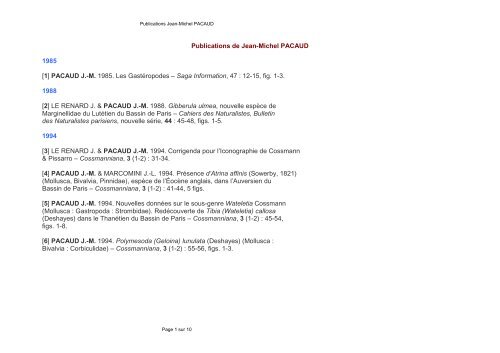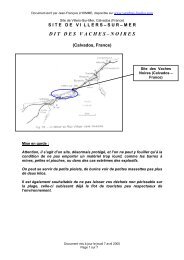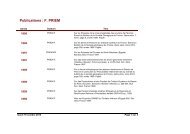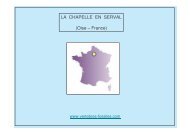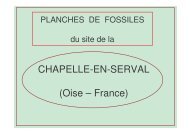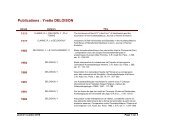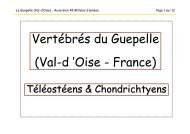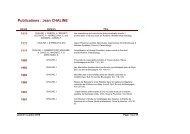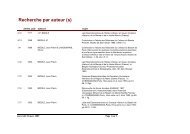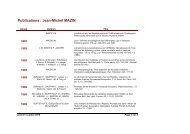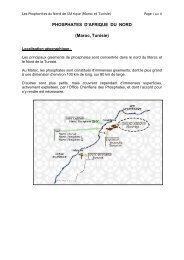Publications de Jean-Michel PACAUD 1985 [1 ... - Vertébrés fossiles
Publications de Jean-Michel PACAUD 1985 [1 ... - Vertébrés fossiles
Publications de Jean-Michel PACAUD 1985 [1 ... - Vertébrés fossiles
- No tags were found...
Create successful ePaper yourself
Turn your PDF publications into a flip-book with our unique Google optimized e-Paper software.
<strong>Publications</strong> <strong>Jean</strong>-<strong>Michel</strong> <strong>PACAUD</strong><strong>Publications</strong> <strong>de</strong> <strong>Jean</strong>-<strong>Michel</strong> <strong>PACAUD</strong><strong>1985</strong>[1] <strong>PACAUD</strong> J.-M. <strong>1985</strong>. Les Gastéropo<strong>de</strong>s – Saga Information, 47 : 12-15, fig. 1-3.1988[2] LE RENARD J. & <strong>PACAUD</strong> J.-M. 1988. Gibberula ulmea, nouvelle espèce <strong>de</strong>Marginellidae du Lutétien du Bassin <strong>de</strong> Paris – Cahiers <strong>de</strong>s Naturalistes, Bulletin<strong>de</strong>s Naturalistes parisiens, nouvelle série, 44 : 45-48, figs. 1-5.1994[3] LE RENARD J. & <strong>PACAUD</strong> J.-M. 1994. Corrigenda pour l’Iconographie <strong>de</strong> Cossmann& Pissarro – Cossmanniana, 3 (1-2) : 31-34.[4] <strong>PACAUD</strong> J.-M. & MARCOMINI J.-L. 1994. Présence d’Atrina affinis (Sowerby, 1821)(Mollusca, Bivalvia, Pinnidae), espèce <strong>de</strong> l’Éocène anglais, dans l’Auversien duBassin <strong>de</strong> Paris – Cossmanniana, 3 (1-2) : 41-44, 5 figs.[5] <strong>PACAUD</strong> J.-M. 1994. Nouvelles données sur le sous-genre Wateletia Cossmann(Mollusca : Gastropoda : Strombidae). Redécouverte <strong>de</strong> Tibia (Wateletia) callosa(Deshayes) dans le Thanétien du Bassin <strong>de</strong> Paris – Cossmanniana, 3 (1-2) : 45-54,figs. 1-8.[6] <strong>PACAUD</strong> J.-M. 1994. Polymesoda (Geloina) lunulata (Deshayes) (Mollusca :Bivalvia : Corbiculidae) – Cossmanniana, 3 (1-2) : 55-56, figs. 1-3.Page 1 sur 10
<strong>Publications</strong> <strong>Jean</strong>-<strong>Michel</strong> <strong>PACAUD</strong>1995[7] LE RENARD J. & <strong>PACAUD</strong> J.-M. 1995. Révision <strong>de</strong>s Mollusques paléogènes duBassin <strong>de</strong> Paris. II : Liste <strong>de</strong>s références primaires <strong>de</strong>s espèces – Cossmanniana, 3(3) : 65-132.[8] <strong>PACAUD</strong> J.-M. & LE RENARD J. 1995. Révision <strong>de</strong>s Mollusques paléogènes duBassin <strong>de</strong> Paris. IV : Liste systématique actualisée – Cossmanniana, 3 (4) : 151-187.1997[9] <strong>PACAUD</strong> J.-M. 1997. Un nouveau genre d’Hydrobiidae (Gastropoda,Prosobranchia) du Paléogène du Bassin <strong>de</strong> Paris – Cossmanniana, 4 (1-2),décembre 1996 (publ. avril 1997) : 1-14, figs. 1-33.[10] LE RENARD J. & <strong>PACAUD</strong> J.-M. 1997. Révision <strong>de</strong>s Mollusques paléogènes duBassin <strong>de</strong> Paris. V : Commentaire sur l’in<strong>de</strong>x général <strong>de</strong>s espèces –Cossmanniana, 4 (1-2), décembre 1996 (publ. avril 1997) : 25-28.1998[11] <strong>PACAUD</strong> J.-M. 1998. Un nouveau genre <strong>de</strong> Pholadidae (Mollusca : Bivalvia) duPaléogène inférieur du Nord <strong>de</strong> l’Atlantique – Apex, 13 (1) : 63-75, figs. 1-34, 1 tabl.[12] <strong>PACAUD</strong> J.-M. 1998. Nouvelles données sur le genre Popenoeum (Mollusca,Pseudolividae). Remarques taxonomiques sur une espèce ubiquiste du Paléocèneinférieur, Popenoeum ambiguum (Binkhorst, 1861) – Cossmanniana, 5 (1-2),décembre 1997 (publ. décembre 1998) : 1-28, figs. 1-22, 2 tabl.Page 2 sur 10
<strong>Publications</strong> <strong>Jean</strong>-<strong>Michel</strong> <strong>PACAUD</strong>1999[13] <strong>PACAUD</strong> J.-M. & SCHNETLER K.I. 1999. Revision of the Gastropod familyPseudolividae from the Paleocene of West Greenland and Denmark – Bulletin of theGeological Society of Denmark, 46 : 53-67, pl. 1-4, text-fig. 1-4.2000[14] <strong>PACAUD</strong> J.-M. & TRACEY S. 2000. The occurrence of the genus FusulculusBouchet et Vermeij (Gastropoda, Pseudolividae) in the Eocene of England, with<strong>de</strong>scription of two new species – Tertiary Research, 20 (1-4) : 53-58, pl. 1, 2 tabl.[15] <strong>PACAUD</strong> J.-M., MERLE D. & MEYER J.-C. 2000. La faune danienne <strong>de</strong> Vigny (Vald’Oise, France), importance pour l’étu<strong>de</strong> <strong>de</strong> la diversification <strong>de</strong>s mollusques audébut du Tertiaire – Comptes Rendus <strong>de</strong> l’Académie <strong>de</strong>s Sciences, Sciences <strong>de</strong> laTerre et <strong>de</strong>s Planètes, Série II a, 330 (12) : 867-873, text-fig. 1-2, 1 tabl.[16] DOLIN C. & <strong>PACAUD</strong> J.-M. 2000. Deux espèces nouvelles <strong>de</strong> l’Éocène moyenfrançais rapportées au genre Nodilittorina (Gastropoda, Littorinidae) –Cossmanniana, 7 (1-4) : 53-62, text-figs. 1-6.[17] <strong>PACAUD</strong> J.-M. 2000. L’holotype <strong>de</strong> Latirus (Latirulus) lhommei (Staadt, 1908)(Gastropoda, Buccinidae) retrouvé – Cossmanniana, 7 (1-4) : 63-65, figs. 1-4.Page 3 sur 10
<strong>Publications</strong> <strong>Jean</strong>-<strong>Michel</strong> <strong>PACAUD</strong>2001[18] <strong>PACAUD</strong> J.-M. 2001. Première observation du genre Pulvinites (Mollusca :Bivalvia) dans le Danien (Paléocène inférieur) <strong>de</strong> Vigny (Val d’Oise, France) –Geodiversitas, 23 (1) : 5-16, text-fig. 1-4, 2 tabl.[19] SCHNETLER K.I., LOZOUET P. & <strong>PACAUD</strong> J.-M. 2001. Revision of the gastropodfamily Scissurellidae from the Middle Danian (Paleocene) of Denmark – Bulletin ofthe Geological Society of Denmark, 48 : 79-90, pl. 1-3, 1 text-fig.[20] <strong>PACAUD</strong> J.-M. 2001. Nouvelles données sur les espèces Pholas xylophaginaDeshayes, 1856 et Pholas tripartita Deshayes, 1856 (Bivalvia : Pholadidae) duThanétien (Paléocène) du Bassin <strong>de</strong> Paris, et <strong>de</strong>scription d’une espèce nouvelle dugenre Xylophaga – Cossmanniana, 8 (1-4) : 41-46, fig. 1-6.2002[21] <strong>PACAUD</strong> J.-M. & DOLIN L. 2002. case 3220 : Ovula gisortiana Passy, 1859(currently Gisortia gisortiana : Mollusca, Gastropoda) : proposed prece<strong>de</strong>nce of thespecific name over that of Cypraea coombii Sowerby in Dixon , 1850 – Bulletin ofZoological Nomenclature, 59 (3) : 173-175, fig. 1-2.[22] MERLE D. & <strong>PACAUD</strong> J.-M. 2002. First record of Poirieria subcristata (d’Orbigny,1850) (Muricidae: Muricinae) in the Lower Cuisian of the Paris Basin (Celles-sur-Aisne, Aizy Formation), with comments on the sculptural evolution of somePalaeocene and Eocene Poirieria and Paziella – Tertiary Research, 21 (1-4), 2000(publ. 2002) : 19-27, pl. 1, text-fig. 1-5, 1 tabl.[23] <strong>PACAUD</strong> J.-M. & MERLE D. 2002. Alci<strong>de</strong> d’Orbigny, un précurseur dans l’étu<strong>de</strong><strong>de</strong> la faune du Danien du Bassin <strong>de</strong> Paris (France) in Alci<strong>de</strong> d’Orbigny. 2. VoyageurNaturaliste et systématicien – Comptes Rendus Palévol, 1 (7) : 587-598, text-fig. 1-4.Page 4 sur 10
<strong>Publications</strong> <strong>Jean</strong>-<strong>Michel</strong> <strong>PACAUD</strong>[24] MERLE D. & <strong>PACAUD</strong> J.-M. 2002. The Early Paleogene Muricid (Mollusca :Neogastropoda) from the Oiching beds (Hausberg area, Salzburg, Austria) : revisionand addition to the knowledge of the evolution of the Palaeocene and Lower EocenePoirieria – Mitteilungen Bayerische Staatssammlung für Paläontologie undHistorische Geologie, 42 : 3-14, 1 text-fig., pl. 1-3.2003[25] <strong>PACAUD</strong> J.-M. 2003. First fossil records of the Recent Ovulid genusPseudocypraea Schil<strong>de</strong>r, 1927 (Mollusca : Gastropoda) with <strong>de</strong>scription of a newspecies – Geodiversitas 25 (3) : 451-462, text-fig. 1-6.2004[26] <strong>PACAUD</strong> J.-M. 2004. Comment on the proposed prece<strong>de</strong>nce of Ovula gisortianaPassy, 1859 over Cypraea coombii J. <strong>de</strong> C. Sowerby in Dixon , 1850 (Mollusca,Gastropoda) – Bulletin of Zoological Nomenclature, 61 (1) : 40-42.[27] MERLE D. & <strong>PACAUD</strong> J.-M. 2004. Addition to the knowledge of the LowerPalaeogene Eocithara Fischer, 1883 (Neogastropoda: Harpidae: Harpinae) andphylogenetic analysis of some related genera – Geodiversitas 26 (1) : 61-87, text-fig.1-10.[28] THOMAS H., GHEERBRANT E. & <strong>PACAUD</strong> J.-M. 2004. Découverte <strong>de</strong> squelettessubcomplets <strong>de</strong> mammifères (Hyracoi<strong>de</strong>a) dans le Paléogène d’Afrique (Libye) –Comptes Rendus Palévol, 3 (3) : 209-217.[29] <strong>PACAUD</strong> J.-M. 2004. Révision <strong>de</strong>s mollusques du Danien (Paléocène inférieur)du Bassin <strong>de</strong> Paris. 1. Gastropoda : Patellogastropoda et Vetigastropoda (pro parte)– Geodiversitas 26 (4) : 577-629.Page 5 sur 10
<strong>Publications</strong> <strong>Jean</strong>-<strong>Michel</strong> <strong>PACAUD</strong>2005[30] <strong>PACAUD</strong> J.-M. & LOUBRY P. 2005. Gisortia (s.str.) gisortiana (Passy, 1859), ungéant chez les Cypraeidae – Xenophora, 110 : 14-19, figs. 1-4.2006[31] <strong>PACAUD</strong> J.-M. & LEROY A. 2006. Nouvelles espèces <strong>de</strong> TerebellopsisLEYMERIE, 1846 (Mollusca, Gastropoda, Strombidae) <strong>de</strong> l’Éocène inférieur <strong>de</strong>sBassins <strong>de</strong> Paris et d’Aquitaine – Revue <strong>de</strong> Paléobiologie 25 (2) : 633-641, pl. 1-2.2007[32] <strong>PACAUD</strong> J.-M. 2007. Nouveautés nomenclaturales et taxonomiques introduitespar Alci<strong>de</strong> d’Orbigny dans le Prodrome (1850, 1852) pour les espèces du Paléocèneet <strong>de</strong> l’Éocène – Geodiversitas 29 (1) : 17-86.[33] CAZE B., MERLE D. & <strong>PACAUD</strong> J.-M. 2007. Intérêt systématique <strong>de</strong> l’étu<strong>de</strong> <strong>de</strong>smotifs colorés résiduels chez les mollusques du Cénozoïque d’Europe. Congrès <strong>de</strong>l’Association Paléontologique Française. Paléontologie : à l’interface <strong>de</strong>s Sciences<strong>de</strong> la Terre et <strong>de</strong> la Vie , Digne-les Bains. Journal <strong>de</strong> l’Association PaléontologiqueFrançaise 52 : 51.[34] <strong>PACAUD</strong> J.-M. & LEDON D. 2007. Sur les espèces <strong>de</strong> mollusques du Ludien(Priabonien, Éocène supérieur) du Bassin <strong>de</strong> Paris introduites par Périer en 1941 –Cossmanniana 11 (1-4) : 7-25, pl. 1-4.Page 6 sur 10
<strong>Publications</strong> <strong>Jean</strong>-<strong>Michel</strong> <strong>PACAUD</strong>2008[35] <strong>PACAUD</strong> J.-M. 2008. Sur les spécimens types et figurés <strong>de</strong>s taxons relatifs àGisortia (s.str.) coombii (Soxerby in Dixon, 1850) (Gastropoda, Cypraeoi<strong>de</strong>a) –Cossmanniana 12 (1-4) : 1-45.[36] <strong>PACAUD</strong> J.-M. 2008. L’original <strong>de</strong> Gisortia gigantea pterophora SCHILDER, 1927(Mollusca, Gastropoda, Cypraeoi<strong>de</strong>a) retrouvé – Cossmanniana 12 (1-4) : 47-53.[37] MERLE D., <strong>PACAUD</strong> J.-M., KRILOFF A. & LOUBRY P. 2008. Les motifs colorésrésiduels <strong>de</strong>s coquilles lutétiennes du bassin <strong>de</strong> Paris In : MERLE D. StratotypeLutétien. MNHN, Paris ; Biotope, Mèze ; BRGM, Orléans (Patrimoine géologique 1)pp. 182-227, pls. 18-35.[38] <strong>PACAUD</strong> J.-M. 2008. Le contenu paléontologique du Lutétien du bassin <strong>de</strong> Paris :Mollusca et Brachiopoda In : MERLE D. Stratotype Lutétien. Stratotype Lutétien.MNHN, Paris ; Biotope, Mèze ; BRGM, Orléans (Patrimoine géologique 1) pp. 35 et40-95.[39] <strong>PACAUD</strong> J.-M., BUDIL P. HOLLOWAY D. & HÖRBINGER F. 2008. Questionablesyntypes of Asaphus hausmanni Brongniart, 1822 (Trilobita, Lower Devonian) in thecollection of the Museum national d’Histoire Naturelle, Paris . PalaeontologicalWorkshop held in honour of Doc. RNDr. Jaroslav Kraft, CSc. (9.4.1940 – 10.1.2007),Czech Geological Society, Prague , 39-44.[40] <strong>PACAUD</strong> J.-M. 2008. Terebellomimus quaggiottoi n. gen., n. sp., (Mollusca,Gastropoda, Littorinimorpha, Rostellariidae) du Lutétien inférieur (Éocène moyen) duVicentin (Italie) – Geodiversitas 30 (4) : 721-729.Page 7 sur 10
<strong>Publications</strong> <strong>Jean</strong>-<strong>Michel</strong> <strong>PACAUD</strong>2009[41] <strong>PACAUD</strong> J.-M. 2009. Maralsenia, un nouveau genre <strong>de</strong> Pseudolividae (Gastropoda, Muricoi<strong>de</strong>a) duPaléogène inférieur <strong>de</strong>s régions nord-africaine et sud-américaine. Bulletin <strong>de</strong> l’Institut scientifique <strong>de</strong> Rabat,section Sciences <strong>de</strong> la Terre, 31 : 1-7.[42] DOLIN L. & <strong>PACAUD</strong> J.-M. 2009. Les Cypraeoi<strong>de</strong>a et Velutinoi<strong>de</strong>a (Mollusca, Caenogastropoda) duLutétien inférieur du Vicentin et du Véronais (nord-est <strong>de</strong> l’Italie). Revue <strong>de</strong> Paléobiologie, 28 (2) : 277-314.[43] <strong>PACAUD</strong> J.-M. 2009. Révision <strong>de</strong>s mollusques du Danien (Paléocène inférieur) du Bassin <strong>de</strong> Paris. 2.Neritimorpha (Mollusca, Gastropoda). Revue <strong>de</strong> Paléobiologie, 28 (2) : 349-369.2010[44] <strong>PACAUD</strong> J.-M. 2010. Description <strong>de</strong>s rhyncholites <strong>de</strong>s Nautiles (Mollusca, Cephalopoda) duPaléogène <strong>de</strong>s Bassins <strong>de</strong> Paris, d’Aquitaine et <strong>de</strong>s Corbières (France). Geodiversitas, 32 (1) : 121-156.[45] SYMONDS M.F. & <strong>PACAUD</strong> J.-M. New species of Neritidae (Neritimorpha) from the Ypresian andBartonian of the Paris and Basse-Loire Basins, France. Zootaxa, 2606 : 55-68, text-fig. 1-9.Page 8 sur 10
<strong>Publications</strong> <strong>Jean</strong>-<strong>Michel</strong> <strong>PACAUD</strong>Résumé <strong>de</strong> congrès et rapports[1] <strong>PACAUD</strong> J.-M., MERLE D., PERRIN C. & LAURIAT-RAGE A. 1997. Des sites auxcollections : une évaluation basée sur les macrofaunes d’invertébrés tertiaires duBassin <strong>de</strong> Paris sensu lato. Journée nationale du patrimoine géologique, Paris, 1Page + 1 poster.[2] MERLE D., <strong>PACAUD</strong> J.-M., MEYER J.-C., MONTENAT C. & BARRIER P. 2000. LaMalacofaune danienne <strong>de</strong> Vigny (Val d’Oise), son importance dans l’approche <strong>de</strong> ladiversification <strong>de</strong>s Mollusques au début du Tertiaire, RST 2000, 18ème réunion <strong>de</strong>sSciences <strong>de</strong> la Terre, Paris, p. 195.[3] ADNET S., BARDET N., CAPETTA H., GHEERBRANT E., JOUVES S., <strong>PACAUD</strong> J.-M.PEREDA X. & SUDRE J. 2001. Vertébrés <strong>de</strong>s phosphates du Maroc. Rapport <strong>de</strong> lamission paléontologique Avril-Mai 2001, 11 p.[4] MERLE D. & <strong>PACAUD</strong> J.-M. 2002. Alci<strong>de</strong> d’Orbigny, un précurseur dans l’étu<strong>de</strong> <strong>de</strong>la faune du Danien du Bassin <strong>de</strong> Paris, Colloque International Alci<strong>de</strong> d’Orbigny, savie et son œuvre. Histoire <strong>de</strong> la Stratigraphie <strong>de</strong> d’Orbigny à nos jours, Paris, p. 37.[5] CAZE B., MERLE D., SAINT MARTIN J.-P. & <strong>PACAUD</strong> J.-M. 2008. Distribution <strong>de</strong>sMotifs colorés résiduels chez les mollusques du Cénozoïque d’Europe et intérêtSystématique. L’exemple <strong>de</strong>s Seraphsidae du Paléogène du Bassin <strong>de</strong> Paris, RST2008, 22ème réunion <strong>de</strong>s Sciences <strong>de</strong> la Terre, Nancy, p. 24.[6] <strong>PACAUD</strong> J.-M. 2008. La typothèque dans les collections d’Invertébrés <strong>fossiles</strong> duMNHN. Tipoteca colec_iei <strong>de</strong> nevertebrate fosile a Muzeului Na_ional <strong>de</strong> Istorienatural_ din Paris. Atelier scientifique Franco-roumain. Atelier _tiin_ific Franco-roman,Bucarest.[7] MERLE D., CAZE B., SAINT MARTIN J.-P. & <strong>PACAUD</strong> J.-M. 2009. The residual colour patterns of the European Cenozoic molluscs: a newtaxonomic tool. Seventh Romanian Symposium on Palaeontology, Cluj-Napoca , Pressa Universiara Clujeana, p. 71.Page 9 sur 10
<strong>Publications</strong> <strong>Jean</strong>-<strong>Michel</strong> <strong>PACAUD</strong>[8] MERLE D., CAZE B., SAINT MARTIN J.-P. & <strong>PACAUD</strong> J.-M 2009. Les motifs colorés résiduels <strong>de</strong>s Mollusques <strong>fossiles</strong> : un nouvel instrumenttaxonomique, 2 ème journée d’Étu<strong>de</strong>s sur la géologie algérienne, Université d’Oran, Algérie, p. 25.Page 10 sur 10


